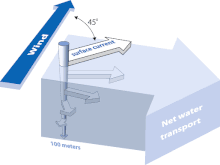It has been suggested that this article be merged into Ekman layer. (Discuss) Proposed since March 2024. |

The Ekman spiral is an arrangement of ocean currents: the directions of horizontal current appear to twist as the depth changes.[1] The oceanic wind driven Ekman spiral is the result of a force balance created by a shear stress force, Coriolis force and the water drag. This force balance gives a resulting current of the water different from the winds. In the ocean, there are two places where the Ekman spiral can be observed. At the surface of the ocean, the shear stress force corresponds with the wind stress force. At the bottom of the ocean, the shear stress force is created by friction with the ocean floor. This phenomenon was first observed at the surface by the Norwegian oceanographer Fridtjof Nansen during his Fram expedition. He noticed that icebergs did not drift in the same direction as the wind. His student, the Swedish oceanographer Vagn Walfrid Ekman, was the first person to physically explain this process.[2]
- ^ US Department of Commerce, National Oceanic and Atmospheric Administration. "The Ekman Spiral - Currents: NOAA's National Ocean Service Education". oceanservice.noaa.gov. Retrieved 2024-02-07.
- ^ Ekman, V. W. 1905. On the influence of the Earth's rotation on ocean currents. Arch. Math. Astron. Phys., 2, 1-52. [1]